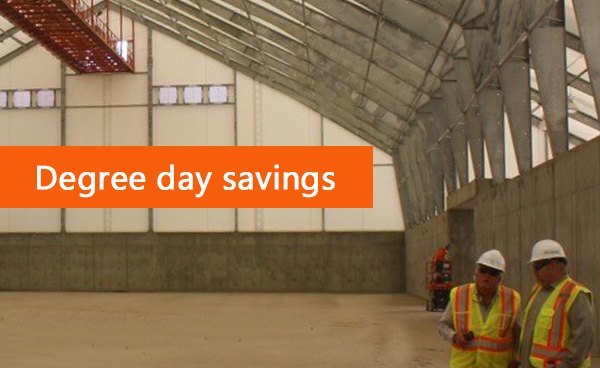
While shade doesn’t technically reduce the lower temperature, it does feel cooler. Getting out of the sun’s rays immediately feels up to 15° cooler than being in direct sunlight. For commercial storage structures requiring extreme ventilation, a simple pavilion structure will make the area feel cooler without disrupting airflow in any direction.
Of course, the sun also provides plentiful (and free) light, the key is striking a balance between too much heat and not enough light. A semi-translucent building material, such as architectural fabric, is the answer. Fabric buildings have abundant light streaming in through the walls and ceiling, providing natural light without dark corners, while deflecting the harsh, hot rays of the sun. Because there’s already plenty of light without adding windows, there are no concentrations of radiant heat – just a consistent, comfortable interior.
Use fabric buildings for less thermal conductivity
The commercial storage structure’s cladding dictates the interior temperature, particularly in uninsulated buildings. Building materials with a high thermal conductivity, such as steel, will magnify the outside conditions. Steel has a thermal conductivity level of 43W/(m K). Think of a piece of steel left out in the sun, both sides of the steel are still hot to the touch hours after the sun goes down. The same will be true of a steel building, after sitting in the sun, the steel will turn hot, raising the temperature inside the building.
Typical fabric buildings have PVC or PE cladding. The thermal conductivity of PVC and PE cladding are nearly immeasurable, with W/(m K) lower than one. With such low thermal conductivity, the heat stays outside and fabric buildings naturally stay cooler than steel-cladded buildings.
Ventilation options in commercial storage structures
A well-ventilated building will have the effect of a cooling breeze, even without wind disturbing the contents of the building. Passive ventilation systems use gravity and natural means to achieve air circulation.
The best way to feel the cooling effects of ventilation is to keep cool air flowing in at a low level, where it will be felt by people or objects inside, while exhausting hot air high overhead. You probably remember learning that heat rises; while this isn’t technically accurate, it’s true that hot air will rise above cool air.
With a custom-engineered fabric building, ventilation is achieved through whatever means are best for you. A common method is to combine mesh panels under the overhang with peak exhaust vents. This keeps cool air coming in at the eave strut, where it will be felt inside, and moves hot air to the top of the building and eventually back outside.
Even in cold or temperate climates, it’s smart to design a commercial storage structure that stays naturally cooler. By making a few smart choices, you’ll be protecting stored material from the effects of extreme heat.

